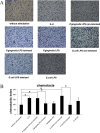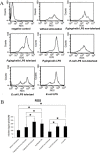Effects of Porphyromonas gingivalis LipopolysaccharideTolerized Monocytes on Inflammatory Responses in Neutrophils
- PMID: 27536946
- PMCID: PMC4990254
- DOI: 10.1371/journal.pone.0161482
Effects of Porphyromonas gingivalis LipopolysaccharideTolerized Monocytes on Inflammatory Responses in Neutrophils
Erratum in
-
Correction: Effects of Porphyromonas gingivalis LipopolysaccharideTolerized Monocytes on Inflammatory Responses in Neutrophils.PLoS One. 2016 Oct 21;11(10):e0165568. doi: 10.1371/journal.pone.0165568. eCollection 2016. PLoS One. 2016. PMID: 27768765 Free PMC article.
Abstract
Periodontitis is a chronic inflammatory disease induced by bacteria. Exposure of the host to periodontal pathogens and their virulence factors induces a state of hyporesponsiveness to subsequent stimulations, which is termed endotoxin tolerance. The role and mechanism of lipopolysaccharide (LPS)-tolerized monocytes in inflammatory responses in neutrophils are currently unclear. Here, conditioned supernatants were collected from THP-1 cells treated with or without repeated 1 μg/ml Porphyromonas gingivalis (P.gingivalis) LPS. The chemotactic response of freshly isolated neutrophils recruited by supernatants was determined by a transwell migration assay, which demonstrated a reduced migration of neutrophils stimulated with supernatants from tolerized THP-1 cells in comparison to non-tolerized THP-1 cells. In addition, there was a marked increase in reactive oxygen species (ROS) generation and a significant decrease in Caspase 3 activities in neutrophils treated with supernatants from THP-1 cells that were treated repeatedly with P.gingivalis LPS in comparison to single treatment. A cytokine antibody array was then used to assess cytokine expression patterns in THP-1 cells. In tolerized THP-1 cells, 43 cytokine (43/170) expression levels were decreased, including chemokine ligand 23 (CCL23) and IFN-γ, while 11 cytokine (11/170) expression levels were increased, such as death receptor 6 (DR6). Furthermore, there was decreased production of IFN-γ and epithelial neutrophil activating peptide-78 (ENA-78) in THP-1 cells after stimulation with repeated P. gingivalis LPS in comparison to single challenge, which was confirmed by ELISA. Therefore, P.gingivalis LPS- tolerized THP-1 cells were able to depress neutrophil chemotaxis and apoptosis, and contribute to respiratory burst, which might be related to the changes in cytokine expression patterns in THP-1 cells.
Conflict of interest statement
Figures




References
-
- Xiong Y, Murphy M, Manavalan TT, Pattabiraman G, Qiu F, Chang HH, et al. Endotoxin Tolerance Inhibits Lyn and c-Src Phosphorylation and Association with Toll-Like Receptor 4 but Increases Expression and Activity of Protein Phosphatases. J Innate Immun. 2016; 8: 171–84. 10.1159/000440838 - DOI - PMC - PubMed
MeSH terms
Substances
LinkOut - more resources
Full Text Sources
Other Literature Sources
Research Materials

